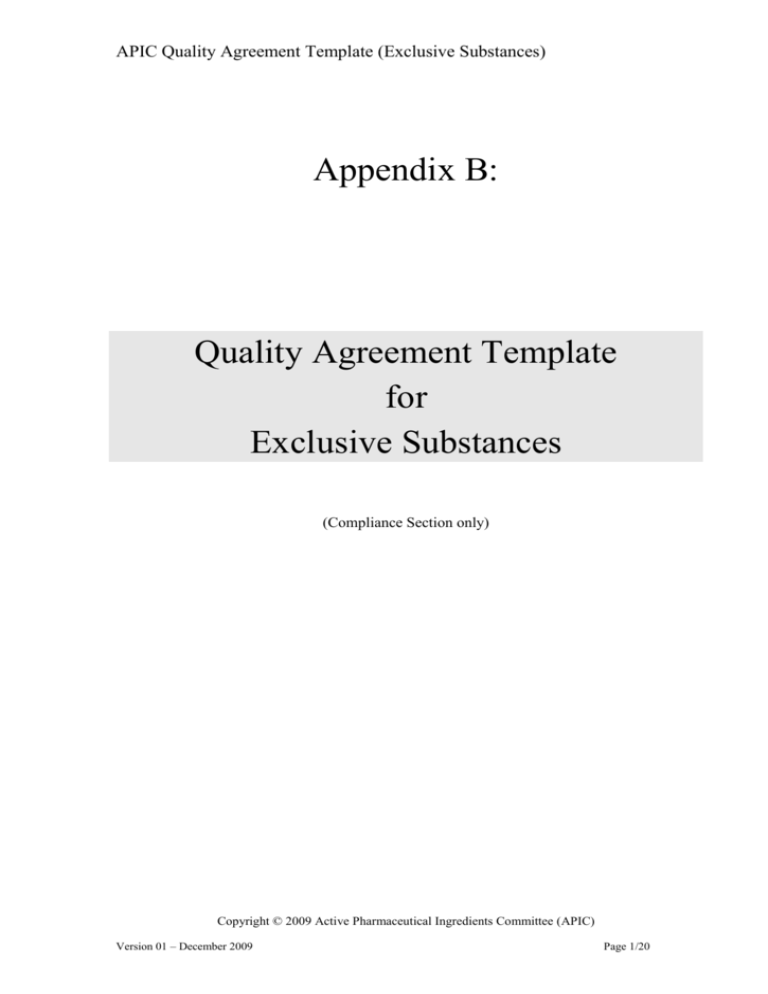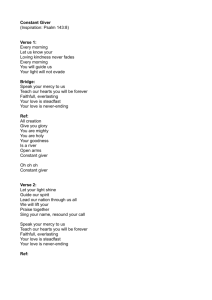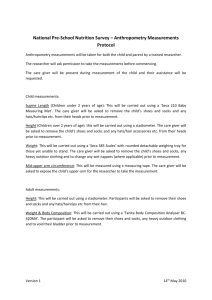Exclusive Substances - Active Pharmaceutical Ingredients Committee
advertisement

APIC Quality Agreement Template (Exclusive Substances) Appendix B: Quality Agreement Template for Exclusive Substances (Compliance Section only) Copyright © 2009 Active Pharmaceutical Ingredients Committee (APIC) Version 01 – December 2009 Page 1/20 APIC Quality Agreement Template (Exclusive Substances) Scope: APIs or intermediates exclusively made for one customer under a toll manufacturing contract as to EU GMP Guide Part I, chapter 7 or ICH Q7, chapter 16 (“Contract Manufacturing”, also known as “Custom Synthesis”), including substances still under development resp. for use in clinical trials. 1. Applicable GMP Standard CONTRACT ACCEPTOR shall manufacture the SUBSTANCE(s) listed in Appendix X in compliance with cGMP. “Current Good Manufacturing Practices” (cGMP) means all applicable standards relating to the manufacture of the SUBSTANCE(s) listed in Appendix X. For the purposes of this agreement, cGMP shall mean the principles (i) described in the ICH Q7 Guide, (ii) promulgated by any Governmental Authority having jurisdiction over the manufacture of the SUBSTANCE(s), in the form of laws or guidance documents, where the guidance documents are to be implemented within the pharmaceutical manufacturing industry for such SUBSTANCE(s). Note 1.1: if “regulatory“ and “GMP“ starting materials differ, the information on the start of GMP might be given here. 2. Certificate of Analysis / Conformance (optional) The following documentation is required for batches of SUBSTANCE shipped to CONTRACT GIVER: Certificate of Analysis and Conformance (optional) for each batch, issued by the independent Quality Unit Copies of investigation reports regarding quality incidents (critical deviations, OOS results, or similar), as applicable (see section 20) The Certificates of Analysis and Conformance (optional) shall be dated and signed by a responsible person of the CONTRACT ACCEPTOR’s Quality Unit, or it may be produced by a computer system which provides a degree of control equivalent to that given by a signature. The Certificate of Analysis states that the batch is suitable for release, and it must include – as a minimum – CONTRACT ACCEPTOR name and address, incl. telephone number (original manufacturing site), SUBSTANCE name and grade (if applicable), CONTRACT ACCEPTOR batch/lot number, Reference to the agreed specification, Test parameters and corresponding specification requirements, Test results (numerical, where applicable) for each chemical, physical or microbiological test performed, Date of release and expiration or retest date of the SUBSTANCE. Copyright © 2009 Active Pharmaceutical Ingredients Committee (APIC) Version 01 – December 2009 Page 2/20 APIC Quality Agreement Template (Exclusive Substances) Note 2.1: the date of manufacture is considered as optional. Optional: The Certificate of Conformance states that the subject lot was produced in accordance to the applicable DMF, CEP or pharmacopoeial monograph(s), to the agreed manufacturing process, and in compliance with all applicable cGMP requirements as well as this Quality Agreement. Certificate of Analysis and Certificate of Conformance may be issued as separate documents or combined to a single document, as appropriate. Note 2.2: the Certificate of Analysis may be attached as an appendix; in any case it should match the SUBSTANCE specification. 3. Change Control The CONTRACT ACCEPTOR shall have a documented and effective change control system in place and is required to provide advanced notification to the CONTRACT GIVER of any significant changes to the process, specifications and analytical methods (SUBSTANCE, intermediates and raw materials), storage, labelling and primary packaging, and equipment, which may have an impact on the quality of the SUBSTANCE, and/or on any regulatory applications related to the SUBSTANCE, if possible at least __ (X) months in advance, to allow CONTRACT GIVER to assess the impact of the change upon the SUBSTANCE supplied or its use by CONTRACT GIVER. Principles: SUBSTANCE produced by the new process shall not be accepted unless the process change has first been reviewed and delivery of SUBSTANCE approved by CONTRACT GIVER. Change requests should be supported by appropriate technical documents to support the change and to confirm that technical performance has not been altered. Modifications relating to SUBSTANCE specifications should only take place by a mutual consent between the two parties. For those changes required to comply with applicable laws and regulatory agency requirements, CONTRACT ACCEPTOR shall notify CONTRACT GIVER of such requirements after the CONTRACT ACCEPTOR becomes aware of the need for such change. CONTRACT GIVER shall assess any change request received from CONTRACT ACCEPTOR in a timely manner. Unless there are justified scientific reasons to reject the change request, or regulatory implications why CONTRACT GIVER may not want to pursue the proposed change, CONTRACT GIVER will not unreasonably withhold its approval of the request. CONTRACT GIVER is responsible for the submission of all necessary change notifications to all competent authorities in full compliance with the applicable regulations, respectively. Copyright © 2009 Active Pharmaceutical Ingredients Committee (APIC) Version 01 – December 2009 Page 3/20 APIC Quality Agreement Template (Exclusive Substances) 4. CONTRACT GIVER will inform CONTRACT ACCEPTOR of the receipt of the necessary acknowledgement of the validity of the notification and, depending on the type of change, the acceptance or approval of the change by the competent authorities. Right to Audit The CONTRACT ACCEPTOR shall allow –upon signature of a special confidentiality agreement– CONTRACT GIVER or its representatives to carry out on-site audits by appointment. The CONTRACT ACCEPTOR shall permit all reasonable access to the manufacturing, packaging, warehousing and laboratory areas related to the manufacture of the SUBSTANCE(s), including pertinent documentation. Any such audit shall take place during normal business hours and must not interfere with CONTRACT ACCEPTOR’s manufacturing operations. The results of the audit and the observation(s) shall be sent to the CONTRACT ACCEPTOR by means of a written report. The CONTRACT ACCEPTOR must ensure a satisfactory follow up to the observations made during the audit performed by the CONTRACT GIVER, and take corrective actions mutually agreed upon by the parties. Note 4.1: target timelines for both report and response may be added; a 4-weeks period is quite common, respectively. The audit frequency shall depend upon the results of the previous audit(s) and the quality performance of the CONTRACT ACCEPTOR. In the absence of critical quality incidents the frequency shall be not more than once every ___ (X) years. If quality issues arise CONTRACT GIVER shall have the right to audit more frequently. Note 4.2: in the absence of quality issues one audit every 3 years can be considered as industry standard. 5. Authority Inspections The CONTRACT ACCEPTOR shall notify the CONTRACT GIVER of all regulatory authority inspections that are related to the SUBSTANCE, and that take place at the facility where the SUBSTANCE is manufactured or the testing laboratory where any of the associated testing is performed. If areas of concern exist which specifically involve the SUBSTANCE, CONTRACT GIVER should be notified prior to the inspection. In all other cases information on the results of the inspection is appropriate. Such notification will include Written notification of any observation, if any, that may impact the manufacture of the SUBSTANCE Written notification of all related corrective actions and planned completion dates Any further correspondence with the regulatory authority (if the manufacture of the SUBSTANCE is concerned) Copyright © 2009 Active Pharmaceutical Ingredients Committee (APIC) Version 01 – December 2009 Page 4/20 APIC Quality Agreement Template (Exclusive Substances) 6. Sub-contracting 6.1 CONTRACT ACCEPTOR agrees not to sub-contract to a third party or having done by a third party any of the work entrusted to them under this Quality Agreement without CONTRACT GIVER’s prior written approval. If such an agreement is given, CONTRACT ACCEPTOR shall nonetheless remain fully responsible for the quality of the materials or services provided by sub-contractors and for all commitments as agreed upon with this Quality Agreement. This must be assured through quality agreements with the respective sub-contractors and technical delivery specifications. 6.2 A list of currently approved sub-contractors related to the manufacture of the SUBSTANCE(s) is provided in Appendix X. In case that CONTRACT ACCEPTOR would like to use a new sub-contractor this list needs to be updated and is subject of approval by CONTRACT GIVER. Any change in sub-contracting shall follow the established change control procedure. Note 6.1: although “distribution” is part of “manufacture” as to the definition given in the ICH Q7 guideline it is understood that the use of contractors for transportation (haulers) is not in the scope of this section. 7. Retention of samples (SUBSTANCE) Note 7.1: one of the two conditions given in 7.1 should be chosen, depending if an expiry date or a retest date has been defined for the SUBSTANCE. 7.1 CONTRACT ACCEPTOR will store SUBSTANCE retention samples, sufficient to perform at least two (2) full specification analyses, in containers that are equivalent to or more protective than the commercial packaging. Samples are to be retained for < one (1) year after the expiry date of the batch assigned by SUPPLIER or for three (3) years after distribution, which ever is the longer > or < for three (3) years after the batch is completely distributed by SUPPLIER >. Note 7.2: “specification analysis” means “analysis according to the agreed specification” that may be identical with “compendial analysis” (if specification is equivalent to current pharmacopoeial monograph), or different in case there is no pharmacopoeial monograph, or if the agreed specification exceeds the monograph. Samples should be labelled, at least, with the following information: SUBSTANCE name CONTRACT ACCEPTOR batch/lot number Date of manufacture 7.2 CONTRACT ACCEPTOR will make SUBSTANCE retention samples available to CONTRACT GIVER promptly upon CONTRACT GIVER’s justified request. 7.3 CONTRACT ACCEPTOR shall keep available any retention samples relevant to assessing the quality of the SUBSTANCE(s) in the event of complaints and/or recall procedures. This requirement shall continue even in case of termination of the supply of SUBSTANCE(s). In such a case CONTRACT ACCEPTOR may choose to deliver all samples to CONTRACT GIVER instead of keeping them for the required period. Copyright © 2009 Active Pharmaceutical Ingredients Committee (APIC) Version 01 – December 2009 Page 5/20 APIC Quality Agreement Template (Exclusive Substances) 8. Retention of records/documentation Note 8.1: one of the two conditions given in 8.1 should be chosen, depending if an expiry date or a retest date has been defined for the SUBSTANCE. 8.1 CONTRACT ACCEPTOR will store the original master batch records, the executed batch records, and all other original documentation that is related to the manufacture of the SUBSTANCE and that is required to be maintained under cGMPs, protected from destruction and unauthorised access, for < one (1) year after the expiry date of the batch assigned by CONTRACT ACCEPTOR or for three (3) years after distribution, which ever is the longer > or < for three (3) years after the batch is completely distributed by CONTRACT ACCEPTOR >. 8.2 CONTRACT ACCEPTOR will retain the original manufacturing records for validation batches for the entire term of the contract manufacturing agreement. Upon termination of the contract manufacturing agreement, CONTRACT ACCEPTOR will provide CONTRACT GIVER with the original manufacturing records for validation batches. [Note: any other individual agreement between the parties would also be appropriate.] 8.3 Upon CONTRACT GIVER request, CONTRACT ACCEPTOR will promptly make copies of the original records available for CONTRACT GIVER. 8.4 CONTRACT ACCEPTOR will offer CONTRACT GIVER the option to take over the documents before destruction after X years. 8.5 CONTRACT ACCEPTOR shall keep available any records relevant to assessing the quality of the SUBSTANCE(s) in the event of complaints and/or recall procedures. This requirement shall continue even in case of termination of the supply of SUBSTANCE(s). In such a case CONTRACT ACCEPTOR may choose to deliver all documents to CONTRACT GIVER instead of keeping them for the required period. 9. Stability Note 9.1: the level of detail in this section will depend upon how much control the contract giver wants over the contract acceptor. Usually the contract giver desires control over stability protocol/methods/specs as well as access to all data for regulatory submissions. CONTRACT ACCEPTOR will perform stability studies for the SUBSTANCE(s) as per ICH guidelines and CONTRACT GIVER requirements. CONTRACT ACCEPTOR is responsible for assigning re-evaluation dates to the SUBSTANCE(s) and for determining suitable storage and shipping conditions, based upon stability studies. CONTRACT ACCEPTOR is responsible for generating stability protocols, methods and specifications. CONTRACT GIVER is responsible for approving stability protocols, methods and specification. CONTRACT ACCEPTOR will upon request or at least annually provide updated data from the stability program (initial or on-going studies) to CONTRACT GIVER. CONTRACT ACCEPTOR will inform CONTRACT GIVER if there are any adverse trends that could impact on current retest date. Copyright © 2009 Active Pharmaceutical Ingredients Committee (APIC) Version 01 – December 2009 Page 6/20 APIC Quality Agreement Template (Exclusive Substances) 10. Complaints All complaints related to the SUBSTANCE(s) reported, regardless of source (e.g., consumers, doctors, pharmacists, sales representatives) will be handled by CONTRACT GIVER and communicated to CONTRACT ACCEPTOR. CONTRACT ACCEPTOR is responsible for recording and investigating all quality-related complaints on the SUBSTANCE and will maintain the complete complaint database and complaint files. CONTRACT ACCEPTOR will complete their investigation and respond to CONTRACT GIVER in writing to all complaints within 20 business days of receipt. A formal written report on the complaint detailing identifiable root causes and corrective and preventive actions where applicable shall be prepared by CONTRACT ACCEPTOR and sent to the CONTRACT GIVER. In case the investigation could not be finalized within 20 business days, CONTRACT ACCEPTOR will provide an interim report to CONTRACT GIVER. Note 10.1: individual (target) timelines for both initial and concluding responses may be set by the parties; for the concluding response a period of 20 business days is quite common. CONTRACT ACCEPTOR is responsible for implementing a corrective action plan to correct any deficiencies identified during an investigation. The CONTRACT GIVER will make relevant information and samples of the affected SUBSTANCE(s) available to assist in the investigation of the CONTRACT ACCEPTOR. 11. Recall In the event that the CONTRACT ACCEPTOR believes that a recall of the SUBSTANCE(s) maybe necessary or appropriate, the CONTRACT ACCEPTOR shall immediately notify the CONTRACT GIVER. The two parties will take joint decisions on the disposition of SUBSTANCE or (if applicable) finished drug product made thereof or user information, where required. The CONTRACT GIVER is responsible for the final decision and the coordination of any recalls or field alert activities. The CONTRACT ACCEPTOR shall provide any information required by the CONTRACT GIVER relating to recall or field alert activities within two (2) business days of the request, if such information is readily available at the CONTRACT ACCEPTOR. The CONTRACT ACCEPTOR will not initiate any notifications to health authorities concerning a (potential) non-conformance without the prior agreement of CONTRACT GIVER. The CONTRACT ACCEPTOR will collaborate, if needed, in any recall of a defective batch of SUBSTANCE. Copyright © 2009 Active Pharmaceutical Ingredients Committee (APIC) Version 01 – December 2009 Page 7/20 APIC Quality Agreement Template (Exclusive Substances) 12. Product quality review CONTRACT ACCEPTOR shall conduct an annual Product Quality Review (PQR) for the SUBSTANCE(s), according to the requirements of ICH Q7 and any additional requirements mutually agreed between the parties. Note 12.1: a reference to an appendix specifying such additional requirements might be included, if applicable. Since the PQR as to ICH Q7 is usually applicable to commercial products, the parties should define how to handle in case of development products. CONTRACT ACCEPTOR will provide CONTRACT GIVER with copies of the relevant information of its PQR of the previous annual period, - Option 1: upon request, within a reasonable timeframe. - Option 2: within any timeframe mutually agreed between the parties. - Option 3: within 3 months from the closure of the annual period. CONTRACT GIVER shall fulfil any regulatory requirements of regulatory authorities related to the PQR for drug products manufactured from the SUBSTANCE(s). 13. Storage and distribution Notes: 13.1: Storage: special storage requirements for the SUBSTANCE(s) should be clear. 13.2: Distribution: either in the Supply Agreement or in the Quality Agreement the responsibilities for the whole supply chain should be defined; reference to GDP (IPEC, WHO) is recommended. Usually the CONTRACT ACCEPTOR is responsible for the transportation from the manufacturing site to the CONTRACT GIVER’s receiving site. The following text is written in this sense (to be changed, if responsibilities are different). CONTRACT ACCEPTOR shall make commercially reasonable efforts to exclude, during packaging, storage, and shipping of the SUBSTANCE(s), the possibility of deterioration, contamination, or mix-ups with any other material. CONTRACT ACCEPTOR shall comply with the following requirements in relation to distribution of the SUBSTANCE(s). Distribution in accordance with storage conditions stated on the labels Contracts with hauliers and shipping agents Ability to recall SUBSTANCE from distribution network Quarantine SUBSTANCE with questionable quality Utilise tamper evident seals on all packaging CONTRACT ACCEPTOR will qualify hauliers and shipping agents used to transport the SUBSTANCE(s). The list of approved hauliers and shipping agents shall be maintained in Appendix X. CONTRACT ACCEPTOR will send a Certificate of Analysis with each shipment of SUBSTANCE and independently send one to <list recipients here>. CONTRACT ACCEPTOR will provide an up-to-date MSDS to CONTRACT GIVER with each shipment or at least on an annual basis. Copyright © 2009 Active Pharmaceutical Ingredients Committee (APIC) Version 01 – December 2009 Page 8/20 APIC Quality Agreement Template (Exclusive Substances) 14. Undesirable contaminants Note 14.1: the three items listed below constitute the most frequently requested ones. Others may be added as appropriate. 14.1 BSE/TSE CONTRACT ACCEPTOR shall provide to CONTRACT GIVER a BSE/TSE certificate for the SUBSTANCE(s) listed in accordance with the EMEA Note for Guidance EMEA/410/01 (current revision). The certificate shall indicate if the SUBSTANCE(s) is (are) of human or animal origin, and if materials of human or animal origin are used during the manufacturing process of the SUBSTANCE(s). An updated BSE/TSE certificate must be issued after any change to the manufacturing process which involves new raw materials or for raw materials that have been sourced from a different supplier. 14.2 Residual solvents SUPPLIER shall provide to CUSTOMER a residual solvents statement for the SUBSTANCE(s) listed in accordance with the ICH Q3C guideline. An updated statement must be issued after changes to the manufacture of the SUBSTANCE(s), if applicable. 14.3 Metal catalyst/reagent residues SUPPLIER shall provide to CUSTOMER a statement on metal residues for the SUBSTANCE(s) listed in accordance with the EMEA “Guideline on the specification limits for residues of metal catalysts or metal reagents” (EMEA/ CHMP/ SWP/ 4446/ 2000) and other applicable regulations. An updated statement must be issued after changes to the manufacture of the SUBSTANCE(s), if applicable. 15. HAPIs 15.1 CONTRACT ACCEPTOR shall ensure that its facilities are used in line with any authorizations for HAPIs granted by the competent regulatory authority. 15.2 CONTRACT ACCEPTOR shall not conduct production and handling of highly sensitizing materials (such as penicillins or cephalosporins) in the equipment being used for the SUBSTANCE(s). Production of such materials in the same building being used for the SUBSTANCE(s) is permitted only if performed in a closed and dedicated system. 15.3 CONTRACT ACCEPTOR shall not conduct the production of certain additional products, such as certain highly active or toxic drugs and non-medicinal products in the same equipment used for the SUBSTANCE(s). For those products, in exceptional cases, the principle of campaign working in the same facilities can be accepted provided that specific precautions are taken and validated inactivation and/or cleaning procedures are in place. Optional: In case CONTRACT ACCEPTOR intends to conduct production of any such product in the same equipment used for the SUBSTANCE(s), it shall provide CONTRACT GIVER with the necessary information to allow CONTRACT GIVER a proper risk assessment. CONTRACT GIVER will then approve or reject CONTRACT ACCEPTOR’s request on a scientific basis. Copyright © 2009 Active Pharmaceutical Ingredients Committee (APIC) Version 01 – December 2009 Page 9/20 APIC Quality Agreement Template (Exclusive Substances) 16. Raw materials Note 16.1: certain grades or qualities of raw materials may be defined; special requirements with respect to the storage period of retention samples of materials may be stipulated (particularly in development). CONTRACT ACCEPTOR shall be responsible for the purchase, storage, handling, sampling, testing and approval or rejection of materials used in manufacturing the SUBSTANCE(s) pursuant to this agreement, with the exception of any material supplied by CONTRACT GIVER. CONTRACT ACCEPTOR shall implement a vendor qualification program for evaluating the suppliers of critical materials, with the only exception of materials supplied by CONTRACT GIVER. CONTRACT ACCEPTOR shall only purchase materials from qualified suppliers. CONTRACT ACCEPTOR must utilize documented material inspection plans and testing procedures. The results of this inspection and testing must be in accordance with specifications filed by CONTRACT GIVER. CONTRACT ACCEPTOR will inspect and/or test all materials on a batch-by-batch basis. Raw materials supplied by qualified vendors and those supplied by CONTRACT GIVER can be subject to reduced testing but a minimum ID testing (or visual examination in case of hazardous or highly toxic raw materials) needs to be performed for each delivery and each lot. CONTRACT ACCEPTOR shall store and handle materials used in manufacturing the SUBSTANCE(s) pursuant to this agreement under appropriate conditions, consistent with cGMPs, all applicable laws, rules and regulations, and industry standards. CONTRACT GIVER shall inform CONTRACT ACCEPTOR on the storage conditions of any material supplied to CONTRACT ACCEPTOR. CONTRACT ACCEPTOR shall have all necessary and appropriate controls in place to prevent cross-contamination of the raw materials and intermediates used in the manufacture of the SUBSTANCE(s) from other chemicals stored, used, or manufactured by CONTRACT ACCEPTOR, including but not limited to potent hormones, cytotoxic compounds, betalactams, highly potent drugs, biological preparations or non-pharmaceutical chemicals. Optional (if applicable): CONTRACT GIVER shall supply CONTRACT ACCEPTOR with enough amount of intermediate to manufacture the quantities of batches ordered. CONTRACT GIVER warrants that any intermediate supplied to CONTRACT ACCEPTOR shall comply with the agreed specifications. A Certificate of Analysis shall be submitted by CONTRACT GIVER to CONTRACT ACCEPTOR and shall accompany each shipment. The specification in force for the intermediate is attached as Appendix X. CONTRACT GIVER shall be responsible for the maintenance and storage of appropriate retain samples of any material supplied to CONTRACT ACCEPTOR. If CONTRACT ACCEPTOR believes that any shipment of intermediate does not meet specification he will notify it to CONTRACT GIVER in writing, including a detailed explanation of the non-conformity. CONTRACT GIVER shall investigate such alleged nonconformity and, if agrees, such intermediate is non-conformance and CONTRACT GIVER will replace the material or the SUBSTANCE(s) will be manufactured at the sole risk of Copyright © 2009 Active Pharmaceutical Ingredients Committee (APIC) Version 01 – December 2009 Page 10/20 APIC Quality Agreement Template (Exclusive Substances) CONTRACT GIVER. If CONTRACT GIVER disagrees it will notify it to CONTRACT ACCEPTOR in writing. Manufacturing of the SUBSTANCE(s) will be at the sole risk of CONTRACT GIVER. CONTRACT ACCEPTOR shall not be responsible of intermediate’s defects or not meeting specifications. 17. Qualification / Validation Equipment qualification, process validation, analytical methods validation and validation of computerized systems, if used, are in place and covered by change control. Validation documentation shall be available for review during an audit. On request, the CONTRACT GIVER will get copies or summaries from the validation reports. Development: Equipment qualification and change control in place. Verification of analytical methods for intended use (see Note). Note: in some cases, e.g. in case SUBSTANCE lots will be used for clinical phase 3 studies, or prior to the validation campaign at the latest, the analytical methods should be validated according guidelines. 18. Reprocessing Reprocessing shall be performed according to the current regulatory dossier and reported to the CONTRACT GIVER. Reasons for reprocessing have to be investigated, and the results shall be communicated with the CONTRACT GIVER. Development: Reprocessed batches have to be reported and agreed with the CONTRACT GIVER. 19. Reworking Reworking is only possible after approval by CONTRACT GIVER. Any reworking process should be validated. Additional stability tests and analytical testing of reworked batches may be required. Development: Reworked batches have to be reported and approved by CONTRACT GIVER. Reworking process could be part of the experience through process development. 20. Deviations / OOS (incl. stability) CONTRACT ACCEPTOR will notify CONTRACT GIVER promptly in the event of any critical deviation(s) that can potentially affect the integrity of the SUBSTANCE(s). Any advice by CONTRACT GIVER on the handling of the deviation or the affected material (e.g., on root cause analysis or corrective actions) shall be given promptly so that further production is not unreasonably hindered. Copyright © 2009 Active Pharmaceutical Ingredients Committee (APIC) Version 01 – December 2009 Page 11/20 APIC Quality Agreement Template (Exclusive Substances) CONTRACT ACCEPTOR will forward a copy of the completed report on any full-scale OOS investigation to CONTRACT GIVER within a reasonable period of time. For all confirmed OOS stability test results that indicate that the SUBSTANCE(s) has (have) failed to remain within specifications, CONTRACT ACCEPTOR will notify CONTRACT GIVER promptly and provide the stability data. CONTRACT GIVER may participate in any full-scale investigation concerning OOS results. CONTRACT ACCEPTOR will implement any agreed actions arising out of the completed investigation report in order to avoid the reoccurrence of similar issues in the future. 21. Packaging In addition to the requirements in ICH Q7 the following shall apply to the packaging of the SUBSTANCE(s): The specifications for packaging materials including tamper evident seals must be in accordance with the regulatory documentation related to the SUBSTANCE(s). CONTRACT ACCEPTOR shall package the SUBSTANCE(s) using the components, closures and tamper evident seals as specified in Appendix X. Note 21.1: the list in Appendix X may include both primary packaging materials and secondary ones, e.g. pallets, wrapping etc. There may be the need to define and explain any coding on the seals. < List other security measures here (as applicable). > Note 21.2: the following paragraph is only applicable in very specific cases. Optional: When primary packaging material is returned from CONTRACT GIVER to CONTRACT ACCEPTOR for reuse, CONTRACT ACCEPTOR will validate the cleaning procedure(s) used to clean the packaging material. CONTRACT ACCEPTOR shall apply suitable traceability to primary packaging materials such that the manufacturer’s batch can be traced from the batch of the SUBSTANCE(s) supplied. 22. Labelling Notes: 22.1: the shipping label may include additional information (e.g., CONTRACT GIVER material code); details may be defined in the Supply Agreement; 22.2: labelling should be described if done on behalf of the CONTRACT GIVER; 22.3: an example of the label may be provided in the appendix. CONTRACT ACCEPTOR shall comply with the requirements in ICH Q7 in relation to labelling, in particular: Labelling operations shall be conducted to prevent mix ups, Copyright © 2009 Active Pharmaceutical Ingredients Committee (APIC) Version 01 – December 2009 Page 12/20 APIC Quality Agreement Template (Exclusive Substances) Labels shall be checked for accuracy before application, This agreement does not absolve the CONTRACT ACCEPTOR from complying with any legal requirements in relation to the transportation of the SUBSTANCE(s). In addition the following shall apply to the labelling for the SUBSTANCE(s): Optional: CONTRACT ACCEPTOR shall indicate the retest date on the SUBSTANCE label. CONTRACT ACCEPTOR shall use the following batch/lot number format <xxyyzz> where <xx> means <…> and <yy> ….. 23. Regulatory documents CONTRACT GIVER shall be responsible for preparation of registration documents related to SUBSTANCE and finished drug products made from the SUBSTANCE and submission of such registration documents to any regulatory authority, including maintaining such submissions (hereafter altogether called ‘Regulatory Submissions’). Upon request by, and in mutual consultation with CONTRACT GIVER, CONTRACT ACCEPTOR shall be responsible for preparation of documentation on manufacture of SUBSTANCE as required for the Regulatory Submissions of CONTRACT GIVER, limited to CONTRACT ACCEPTOR’s activities under this agreement. CONTRACT GIVER shall provide portions of Regulatory Submissions, related to SUBSTANCE and CONTRACT ACCEPTOR's activities performed under this agreement, to CONTRACT ACCEPTOR for review and written consent, prior to submission to any regulatory authority. CONTRACT ACCEPTOR shall review and comment to CONTRACT GIVER on such portions of Regulatory Submissions, within ___ business days from receipt. CONTRACT GIVER shall, upon submission to any regulatory authority, provide CONTRACT ACCEPTOR with current copies of portions of Regulatory Submissions, including amendments and supplements thereto, related to the SUBSTANCE and CONTRACT ACCEPTOR's activities performed under this agreement. CONTRACT ACCEPTOR will provide, in mutually agreed timelines, all other information related to the SUBSTANCE that CONTRACT GIVER may reasonably request for its Regulatory Submissions, including any data for annual reports (e.g. annual stability reports for the SUBSTANCE). When a change is known to require, or has the potential to require a Regulatory Submission, CONTRACT GIVER will develop a joint strategy to obtain the appropriate regulatory approvals prior to implementation of the change. For change control see section 3. 24. Product release CONTRACT ACCEPTOR has the responsibility to release the SUBSTANCE(s) for shipment to the CONTRACT GIVER. Copyright © 2009 Active Pharmaceutical Ingredients Committee (APIC) Version 01 – December 2009 Page 13/20 APIC Quality Agreement Template (Exclusive Substances) Note 24.1: alternatively, the CONTRACT ACCEPTOR may provide a pre-shipment sample to the CONTRACT GIVER. The CONTRACT GIVER will test that sample, and if OK, will give its approval for shipment to the CONTRACT ACCEPTOR. CONTRACT ACCEPTOR will not ship any SUBSTANCE to any destination, as identified by the CONTRACT GIVER, until the SUBSTANCE is released for shipment, unless prior written approval has been received from the CONTRACT GIVER to perform such a shipment under quarantine. CONTRACT ACCEPTOR is responsible for the issuance for each batch of SUBSTANCE a Certificate of Analysis and Certificate of Conformance (delete, if not appropriate; see also section 2). Optional: CONTRACT GIVER may, in its sole discretion, delegate the final release authority for the SUBSTANCE(s) to CONTRACT ACCEPTOR. CONTRACT GIVER reserves the right to withdraw the delegated final release authority from CONTRACT ACCEPTOR at any time. 25. Reference standards All reference standards should be stored in accordance with the suppliers recommended storage conditions and used within their given expiry or retest date. CONTRACT ACCEPTOR or CONTRACT GIVER (delete as appropriate) is responsible for the purchase and certification of the reference standards. (In case, CONTRACT ACCEPTOR is responsible) CONTRACT ACCEPTOR shall provide to CONTRACT GIVER reasonable quantities of any non-compendial or not commercially available reference standards necessary to perform the tests included in the SUBSTANCE specification. (In case, CONTRACT GIVER is responsible) CONTRACT GIVER shall provide to CONTRACT ACCEPTOR reasonable quantities of any non-compendial or not commercially available reference standards necessary to perform the tests included in the SUBSTANCE specification. 26. Specifications Specifications for the SUBSTANCE(s), intermediates, key raw materials and packaging components, as applicable, are detailed in Appendix X. Any significant changes to these specifications must be approved by the CONTRACT GIVER via a formal change control system (see section 3). 27. Analytical methods Analytical methods used for testing the SUBSTANCE(s): compendial analytical methods must be verified and all others must be validated prior to use. Development: Copyright © 2009 Active Pharmaceutical Ingredients Committee (APIC) Version 01 – December 2009 Page 14/20 APIC Quality Agreement Template (Exclusive Substances) Verification of analytical methods for intended use (see Note). Note: in some cases, e.g. in case SUBSTANCE lots will be used for clinical phase 3 studies, or prior to the validation campaign at the latest, the analytical methods should be validated according guidelines. Any significant changes to these analytical methods must be approved by the CONTRACT GIVER via a formal change control system (see section 3). 28. Manufacturing CONTRACT ACCEPTOR shall have appropriate control procedures in place to ensure that only authorised personnel has access to CONTRACT ACCEPTOR’s manufacturing facilities. Note 28.1: more stringent acceptance criteria for cleaning may be agreed between both parties if requested by CONTRACT GIVER. Such special agreements should be included here. Copyright © 2009 Active Pharmaceutical Ingredients Committee (APIC) Version 01 – December 2009 Page 15/20 APIC Quality Agreement Template (Exclusive Substances) Annex: Division of Responsibilities [ CG = CONTRACT GIVER; CA = CONTRACT ACCEPTOR ] A Regulatory Compliance CG CA X X 1. Adhere to approved registration documentation (Marketing Authorisation, NDA, IND, DMF, CEP, etc, as applicable) 2. Maintaining valid manufacturing license(s), as applicable X 3. Maintaining site master file, as applicable X 4. Approving significant changes X 5. Submitting change notifications/applications to authorities X Note: if necessary and agreed by the parties, responsibilities with respect to purchasing, manufacturing, and testing of materials and intermediates before the API SMs may be added here B Purchasing, Manufacturing and Analytical Testing of API Starting Materials (SMs), Raw Materials, Process Aids, and Intermediates after API SMs, and SUBSTANCE CG CA 6. Setting specifications for SUBSTANCE X 7. Setting specifications for materials and intermediates 8. Purchasing materials according to specifications X 9. Qualifying and monitoring material suppliers X 10. Performing an identity check on incoming material X 11. Testing of incoming material, as appropriate X 12. Generating Master Batch Procedure/Record X 13. Approving Master Batch Procedure/Record 14. Manufacturing SUBSTANCE according to Master Batch Procedure (incl reprocessing, packaging, labelling) X 15. Generating Batch Production Record X 16. Approving Batch Production Record 17. Assigning batch numbers X 18. Sampling of incoming materials X 19. Sampling during production of SUBSTANCE (incl API, if applicable) X 20. Developing analytical test-methods for in process controls (IPCs) X 21. Setting specifications for IPCs X Review Final approval Final approval X X X Copyright © 2009 Active Pharmaceutical Ingredients Committee (APIC) Version 01 – December 2009 Page 16/20 APIC Quality Agreement Template (Exclusive Substances) B Purchasing, Manufacturing and Analytical Testing of API Starting Materials (SMs), Raw Materials, Process Aids, and Intermediates after API SMs, and SUBSTANCE CG CA 22. Performing IPCs 23. Developing and writing analytical test methods for API SMs, raw materials, process aids, intermediates, and SUBSTANCE 24. Validating analytical test methods for API SMs, raw materials, process aids, intermediates, and SUBSTANCE, according to CG expectations 25. Approving analytical test methods and validation protocols and reports 26. Transferring validated analytical methods to CA 27. Releasing SUBSTANCE (according to specifications and based on CoA testing) for shipment to CG 28. Deciding on final disposition of SUBSTANCE X 29. Defining amount for retention samples X 30. Storing retention samples, until shipment to CG (if requested) 31. Investigating OOS results and critical deviations Review and final approval X 32. Approving analytical records for the SUBSTANCE Final approval X 33. Disposing not used materials, intermediates or SUBSTANCE in an environmentally safe manner 34. Purchasing / providing of (certified) reference standards C Purchasing and Testing of Packaging Material X Final approval X X X X X CG CA 35. Specifying packaging material for SUBSTANCE X 36. Specifying packaging material for materials before the SUBSTANCE, if needed X 37. Developing test methods for primary packaging material, if needed X 38. Purchasing packaging material X 39. Testing and releasing primary packaging material X 40. Taking retention samples of primary packaging material X 41. Purchasing tamper evident seals for containers to be shipped to CG X Copyright © 2009 Active Pharmaceutical Ingredients Committee (APIC) Version 01 – December 2009 Page 17/20 APIC Quality Agreement Template (Exclusive Substances) D Labelling, Label Printing and Label Reconciliation (at CA) CG CA 42. SUBSTANCE X 43. Materials and intermediates X 44. Samples X 45. Waste X E Storage and Shipment CG CA X X 46. Storing SUBSTANCE under labelled conditions 47. Qualifying of carrier 48. Preparing SUBSTANCE for dispatch and loading of vehicles X 49. Maintaining storage conditions during transportation until agreed transition point X F Documents (Generation and Approval) CG CA 50. Establishing synthesis scheme (including definition of API SMs) X 51. Generating Master Batch Procedure/Record (ref. to table B) 52. Approving Master Batch Procedure/Record (ref. to table B) 53. Generating Batch Production Record (ref. to table B) 54. Approving Batch Production Record (ref. to table B) 55. Archiving the original documents and sending copies to CG 56. Updating safety data sheet of intermediates and SUBSTANCE, as soon as further relevant information becomes available X 57. Providing Certificates of Analysis and BSE/TSE statements of materials supplied by CG X 58. Providing suppliers’ certificates concerning TSE and origin of raw materials and process aids procured and used by CA X 59. Issuing Certificate of Analysis for SUBSTANCE for shipment to CG X 60. Issuing Certificate of Analysis of SUBSTANCE for final disposition (e.g., technical, toxicological or human use) 61. Issuing notifications on atypical results (e.g., OOE) 62. 63. X X X Review X Issuing reports on full-scale OOS investigations and critical deviations Review or approval X Providing development reports, test procedures, validation documents, etc and other source documents requested by CG Review X Copyright © 2009 Active Pharmaceutical Ingredients Committee (APIC) Version 01 – December 2009 Page 18/20 APIC Quality Agreement Template (Exclusive Substances) G Equipment Cleaning CA 64. Sharing information on toxicity of SUBSTANCE and raw materials, process aids and intermediates, if available X X 65. Establishing solubility of SUBSTANCE and intermediates in cleaning agent used X X 66. Assessing/verifying cleanliness of used equipment X 67. Releasing equipment after cleaning X H Qualification / Validation I CG CG CA 68. Qualifying of equipment, utilities and facilities X 69. Preparing and approving equipment and facility qualification protocols and reports used for the SUBSTANCE(s) X 70. Validating the manufacturing process X 71. Preparing and approving process validation protocols and reports for the SUBSTANCE(s) 72. Validating cleaning procedures 73. Preparing and approving cleaning validation approach applicable to the SUBSTANCE(s) 74. Validating analytical methods 75. Preparing and approving analytical validation approach applicable to the SUBSTANCE(s) 76. Retaining qualification and validation documentation X 77. Validating computerised systems X 78. Preparing and approving validation protocols and reports for computer validation X Stability Program 79. Preparing stability protocol 80. Approving stability protocol 81. Performing stability study under ICH conditions (incl testing) 82. Reviewing stability data and determining retest period 83. Preparing stability report 84. Approving stability report 85. On-going stability studies Final approval X X Final approval X X Final approval CG X CA X Final approval X X Review X X Final approval X X Copyright © 2009 Active Pharmaceutical Ingredients Committee (APIC) Version 01 – December 2009 Page 19/20 APIC Quality Agreement Template (Exclusive Substances) K Product Quality Review 86. Preparing annual PQR report 87. Reviewing PQR reports L Complaints and Recall CG CA X X X CG CA 88. Receiving complaints from external customers X 89. Forwarding complaints related to SUBSTANCE to CA X 90. Investigating complaints related to SUBSTANCE 91. Implementing corrective actions, if necessary 92. Responding to external customers X 93. Deciding to initiate recall X 94. Notifying authorities, external customers, or consumers X X1) 95. Clarifying root cause X X 96. Storing or disposing returned product X X2) X Review X 1) Responsibility to notify local authority in the country of manufacture of SUBSTANCE, if applicable 2) Responsibility regarding SUBSTANCE only M Sub-Contracting CG CA 97. Approving sub-contracting operations 98. Qualifying sub-contractor X 99. Procuring of sub-contracted products or services X Quality monitoring sub-contracted operation X 100. X Copyright © 2009 Active Pharmaceutical Ingredients Committee (APIC) Version 01 – December 2009 Page 20/20






